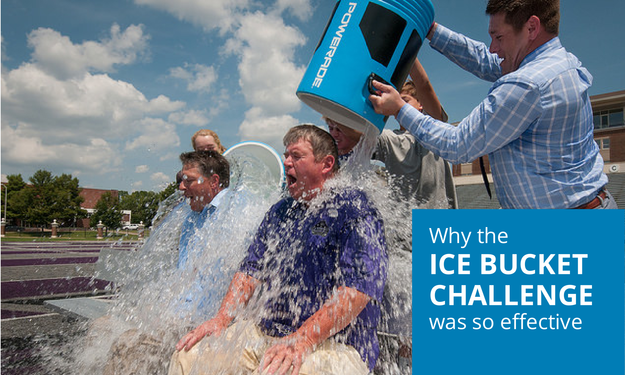By now, you’ve likely seen the ALS Ice Bucket Challenge in your news feed on Facebook or Twitter.
But, in case you’ve missed it, here’s the gist:
- Film a video of yourself getting doused with a bucket of ice water.
- Posts it on social media and then challenge three other people to do the same thing.
- If someone refuses to do the challenge, he or she is encouraged to donate to the ALS Foundation. However, many people choose to both donate and participate in the challenge.
The idea was to raise awareness and funds for ALS, a progressive neurodegenerative disease that strips the brain’s ability to control the movement of muscles.
Certainly, this is a clever campaign to raise awareness for a debilitating disease.
However, I have to admit, I sincerely believed that this viral meme was not doing much to generate funding or awareness for ALS. I thought this was a case of “slactivism” — where it was more about getting “likes” for our own egos instead of raising awareness for this cause.
As of Tuesday, the ALS Foundation has received $22.9 million in funding in the past few weeks. That’s an 1100 percent increase over the $1.9 million in donations they received during the same period last year.
Not to mention, the foundation has added a staggering 453,210 donors to their database. As someone who used to work in non-profit marketing and fundraising, I can tell you this is a big deal.
Although the foundation won’t be able to sustain this level of giving, an increased donor database will give the ALS Foundation the ability to tap into a new crop of donors that could lead to some long-term dollars.
Why the Ice Bucket Challenge was So Effective
So, why has the Ice Bucket Challenge become such a fundraising success?
Here are five key components that created an effective campaign:
1. It wasn’t started by the ALS Association.
Although there are competing stories about its origin, the Ice Bucket Challenge was not started by the ALS Foundation. It picked up steam when friends and family of Pete Frates, a former college baseball standout with ALS, rallied behind this idea to support him.
Because people, not an organization, started this campaign it seemed more genuine and less forced. There was a mission behind the motivation and that, I believe, is part of the magic behind this campaign.
Kudos to the ALS Association for embracing that idea and adopting it as part of your efforts.
2.
It’s entertaining.
Let’s face it. Seeing the reactions of people getting doused with ice water is pretty funny.
In today’s culture of cat memes and viral videos, we want to be entertained. Although this is for a good cause, this challenge certainly gets credit for the entertainment factor.
3.
It has built-in viral component.
The genius part of this campaign is that you are supposed to challenge three other people to participate.
It feels like the online equivalent of a “triple dog dare.” And, much like Marty McFly in Back to the Future, no one likes to be called a chicken.
If you get tagged, you feel compelled to participate and then encourage others to do the same. There is something incredibly powerful about peer pressure.
4.
It’s simple to participate.
Sometimes, campaigns like this can be too cumbersome. If there are too many steps involved, people won’t take the time.
This challenge is something that almost everyone can do and it takes very little time. Most people have access to a bucket with water (something that we shouldn’t take lightly) and the ability to record a quick video to post online.
5.
It has celebrity involvement.
Matt Lauer was one of the early participants in this challenge, so there was a celebrity component early on. As more celebrities got involved, they naturally tagged other celebrities to participate. That went a long way to spread the campaign.
Not only do people love to watch what celebrities do, we also like to imitate them. Participating in this challenge became the “it” thing to do.
What we Can Learn from the #IceBucketChallenge
If you work at a non-profit, you might be tempted to go out and find a way to duplicate this campaign for your cause.
I would caution you against this. Any attempt to try to replicate this for your own organization will likely fall flat.
However, the elements we discussed above are certainly valuable components to creating a campaign that spreads quickly. Keeping these key components in mind as you develop your own awareness and fundraising campaign will be helpful to coming up with your own social media awareness effort.
One Thing I Would Do Differently
But, as my friend, Marjorie Clayman, so aptly pointed out, this campaign doesn’t have a natural tie-in to ALS. Some people do a great job of talking about the disease before dousing themselves with water. But, others don’t.
It would be difficult to find a natural tie-in for ALS, but I think that’s one area where the campaign could certainly be improved. If you can find a way to do something like this in a way that has a better tie-in with your cause, I think the effort would be even more powerful.
If you can find a way to do that and combine it with the components above, you might just have a recipe for success.
So, did I take the Ice Bucket Challenge?
Check out my video to find out!
If you want to join in, go to the ALS Association website to donate today!
What do you think about the ice bucket challenge? Have you participated? Why or why not?
Image Credit: ucentralarkansas




9 replies on “Why the ALS Ice Bucket Challenge Is Brilliant Marketing”
video unavailable? Nooooo.
Apparently, my video was SO epic that YouTube just couldn’t get it loaded. Problem solved, video is now here! Enjoy, Mark! 🙂
http://youtu.be/VRifGeO5jp8?list=UUhUn-qiR2bAm5IJf_ur8edA
Haha! You did it, Laura!
I remember when this challenge first started, the instructions were, “If you do the Ice Bucket Challenge, all you have to donate is $10. If you refuse, you have to donate $100.” I wish I knew which version works better — clear instructions with specific dollar amounts, or no instructions except “donate to ALS if you refuse.” What do you think?
Someone just tagged me for the ALS Ice Bucket Challenge. I’m donating instead! 😉
I did! I really wasn’t going to. But, I just couldn’t resist after Mark challenged me. That, and I’m proud to help raise awareness for a worth cause. 🙂
As to your question, I’ve seen many variations. This past winter, my sisters tagged me in a similar challenge (a polar plunge) and it was donate or take jump into freezing cold water. I just saw people taking the plunge and wondered if people were donating. This time, I think a lot of people are doing both, which I think is far better.
Personally, I don’t like telling people how much to donate. Donating $100 would be a lot for some people, I don’t want to say you have to take the challenge if you can’t cough up the cash.
I hate to seem like the perennial Grinch in your forums Laura, but the Ice Bucket Challenge does not sit well with me. I’ll give you two reasons why. But first– as someone who reads and reports frequently on research into chronic illnesses of all kinds– I don’t begrudge the money raised for ALS one bit. Not one nickel.
But here’s where things go sideways:
1) I bristle and chafe when we imagine the Ice Bucket Challenge “raises awareness” of amyotrophic lateral sclerosis. Watch video after video and I challenge those dumping cold water over their heads to name anything new they’ve learned about the disease, its progression, symptoms, diagnosis, treatment, or avenues of research.
2) As a society, I think it’s a terrible idea– TERRIBLE IDEA– to reinforce the message that peer pressure is acceptable. I will put my donor record up against anyone’s, but I don’t think we need to bring guilt into giving.
And as if that weren’t enough, this: pic.twitter.com/5HH66Kymgh
/okay, end of soapbox
Don’t worry, Stephen. You haven’t earned a grinch badge from us just yet! 😉
To your points – I’m with you on the peer pressure. I *almost* didn’t do it for that very reason. And, if you watched my video and saw my posts on social media channels, I didn’t tag anyone because of that. I didn’t want folks to feel guilted into it.
You’re also right that many videos had nothing to do with ALS. I talked about it in mine because I wanted the focus to be on awareness and fundraising. Many weren’t. But yet, we’re all talking about it and a TON of money was raised. We can’t dispute that this thing has been effective.
My husband shared that graphic with me as well. My hunch is that fundraising for heart disease isn’t as strong because it’s a silent killer and it often happens quickly. Cancer, on the other hand, can go on for a long time and takes a huge toll on families. I think that’s why people tend to donate to cancer more. That, and I think they know how to market.
I’ve had family members die from both so I’m not saying one is worse than another, but that’s my hunch as to why the funding dollars go the way they do.
All of this said, you make some great points. But, I don’t fault this campaign for the things you mentioned. My hope is that other organizations learn from this and we can find ways to better fund these diseases.
Hi Laura,
I realized my arguments might come through as “personal”, but I couldn’t watch your video– when I click it, it says, “This video is private.” Dang YouTube! I’d gladly watch it…
I just remembered one other thing. In your post, “One Thing I Would Do Differently,” you mentioned the Ice Bucket Challenge has no natural tie-in to ALS. Curiously, one of the first descriptions I heard was that the sudden burst of icy water was to reproduce the muscle rigidity and loss of manual dexterity common in many with the disease. (There’s your “raising awareness” right there.)
But there are so many origin stories and variations with the IBC at this point that it’s reached mythical status. Who can separate truth from lore?
If anything, it’s been lightning in a bottle, which is fascinating to observe and often impossible to replicate.
Best,
Stephen
That’s odd – it wasn’t set up that way initially. Not sure what happened. Here you go for your viewing pleasure: http://youtu.be/VRifGeO5jp8
A++! Love the speech, and you put a smile on my face too boot. Now THAT’S how it’s done, people.